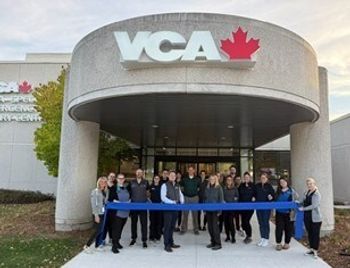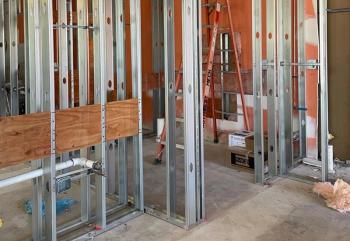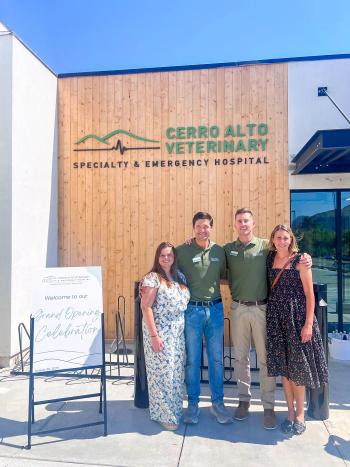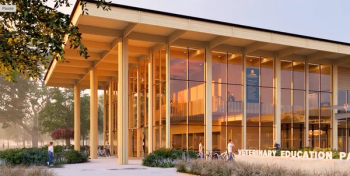
Relishing the rustic charm
Drs. Lamar and Amber Crossland knew they wanted Sunset Canyon Veterinary Clinic in central Texas to appeal to long-time ranchers as well as to the Austin urbanites who'd fled the city for greener pastures in Dripping Springs, Texas. And the mixed animal practice also needed to accommodate a gamut of patients, from livestock to polo horses to pampered pooches. One last requirement: seamless movement between the large animal and small animal sides of the practice, because all staff members worked in both areas.
By Carolyn Chapman, Special Assignments Editor
Drs. Lamar and Amber Crossland knew they wanted Sunset Canyon Veterinary Clinic in central Texas to appeal to long-time ranchers as well as to the Austin urbanites who'd fled the city for greener pastures in Dripping Springs, Texas. And the mixed animal practice also needed to accommodate a gamut of patients, from livestock to polo horses to pampered pooches. One last requirement: seamless movement between the large animal and small animal sides of the practice, because all staff members worked in both areas.
The resulting 8,591-square-foot hospital, boasting native Texas limestone and a smooth traffic flow, garnered praise from hospital design competition judges and won them a 2002 Veterinary Economics Hospital Design Merit Award.
Crossing the road
The Crosslands dreamed of owning a practice after graduating from Louisiana State University in 1990, but they knew it would take a few years of hard work before their dreams came true. Opportunity knocked in 1993, and they jumped to answer. A veterinarian called the Crosslands out of the blue and offered to build and finance a new hospital in Dripping Springs, an untouched area of the hill country 15 miles east of Austin. In this arrangement, the doctors were set to buy the practice outright in three years; the veterinarian who financed the practice acted as a silent partner during that time.
So the doctors moved into a 1,700-square-foot shell. For five years, Drs. Amber and Lamar Crossland built up their practice, gaining experience, a wish list for their next practice, and the money to build their ideal hospital.
In 1998, they started looking for land. The doctors chose a 1.9-acre site across the street from their first facility-a plus when it came to retaining their client base. However, nearly three quarters of the back lot was required for sewage easements, which restricted the building's size and demanded a creative design that divides the practice into two sections, connected by a covered driveway.
The doctors had wisely squirreled away almost every penny of profit for a sizable down payment. And a good relationship with their local bank manager, meticulous record keeping, and strong demographic data smoothed the way for financing. "We were experiencing about 25 percent annual growth, which paved the way for funding," Dr. Lamar Crossland says.
Setting the plan in limestone
"We developed many of the most practical features this practice offers because we found the setup in the old facility inconvenient," says Dr. Lamar Crossland. "For example, the doctors' office and lounge look onto the equine treatment area, an idea born from endless hours of observing fluids running to stubborn colic cases. Our experience also guaranteed that we'd include a shower so we're better prepared when we face a palpation and a poodle appointment back to back." The doctors also included an apartment and a separate entrance to isolation to make sure clients don't spread contaminants by walking through the hospital.
The doctors hired local architects-who happened to be clients, too-James Rodriguez and James Polkinghorn to convert the wish list into a floor plan. "Their experience building in this hill country saved us," Dr. Amber Crossland says. Rodriguez, the primary designer, says the site's major slope made it hard to carve out a level area to walk horses. To take advantage of the level ground available, the architects split the small animal and equine portions from the bovine treatment and large animal boarding area.
Merging city and country
"Our clients have very different needs and wants, and we wanted the new facility design to position us to serve everyone well," Dr. Amber Crossland says. To please rural and urban clients, the doctors selected a native Texan limestone exterior to cover their ranch-house-style practice.
Inside, a vaulted ceiling with exposed rough cedar trusses gives the reception area a rustic feel. Tin paw prints descend from the center of each beam. "The paw print is an appropriate theme for a veterinary clinic," says Dr. Amber Crossland. "It's also the symbol of our local high school team. Supporting your local team is a marketing no-brainer!"
The doctors also used a paw print trail scored into the concrete flooring of the reception area to lead clients to the four exam rooms. The stained and scored honey-colored concrete, which the Crosslands used in public areas of the practice, mimics tile and withstands heavy use.
The small animal portion of the practice occupies the north side of the facility. Pine doorframes reflect the decorating theme established in the reception area, while teal shelving, window frames, and cabinets add a splash of color. Faux granite countertops resist scratches and clean up easily. "We'd change one thing, if we could," says Dr. Amber Crossland. "The rough wall texture in the exam rooms catches dog hair and it's hard to clean."
Doctors access the equine treatment area directly from the pharmacy and lab hallway. An ICU sits behind glass in the treatment area, allowing continual monitoring of critical patients. "Our old clinic had horrendous traffic flow," says co-owner Dr. Glen Portie. "Now we move easily from front to back, and from large animal to small animal. That's what pleases me most about the new hospital."
In the back, indoor/outdoor runs with guillotine doors give dogs space to move around. On the large animal side, the doctors added a covered drop-off area to prevent slips during rainstorms and to link the large animal surgery suite, holding stall, and treatment areas with the bovine treatment, stalls, and runs.
Laying the foundation
So what's the key to surviving the building process? "The best advice I can give is to make sure your relationships are strong before you begin, because they will be tested," says Dr. Amber Crossland.
Think a building project presents enough change for any practice? The Crosslands also brought in a new partner, Dr. Portie, during the building's construction. Dr. Portie had worked with the practice as an associate since 1998, and his buy-in just happened to coincide with building the new facility.
And one final surprise came with the move. "For the first three months, our feet felt like they were stuck in glue," says Dr. Amber Crossland. Dr. Lamar Crossland chalks any problems up to the fact that in the new practice, they had more space to spread out. "We couldn't remember where we put things," he says. "It took us a little while time to get used to the new arrangement."
Today, the team has long since smoothed over the moving-day bumps. "Just as important, our clients are excited about the change, and they appreciate the beauty of our new hospital," Dr. Amber Crossland says.
Carolyn Chapman, a former Veterinary Economics associate editor, is a freelance writer in Liberty, Mo. E-mail your comments or questions to us at ve@vetmedpub.com.
September 2002 Veterinary Economics
Newsletter
From exam room tips to practice management insights, get trusted veterinary news delivered straight to your inbox—subscribe to dvm360.






